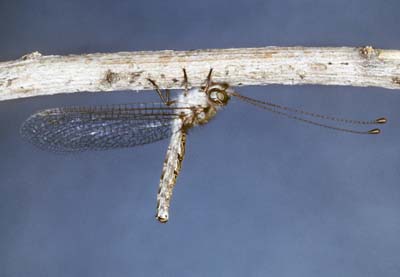
Adult owlfly, Ululodes sp.
(Photographer: Lyle Buss, University of Florida).
Males and females of the same species are similar in appearance, and resemble dragonflies and antlions. The two distinguishing characteristics of owlflies are their long, clubbed antennae (nearly as long as the body) and their bulging eyes. The body of these insects is long and slender (40 to 80 mm in length), and the wings are clear and have a lacy appearance. Some species of owlflies develop some color in their wings after their emergence. Owlflies are strong fliers and ferocious predators who hunt at dusk and dawn. During the day, adult owlflies can be found resting on stems and twigs with their abdomens pointing upward in relation to the body.
Owlflies usually lay their eggs in groups at the tips of limbs and twigs. The female creates a protective shield below the eggs in order to prevent predators from reaching them. Initially, owlfly larvae are usually found in the soil, or in trees where they live in clusters for defensive purposes. Young larvae may conceal themselves under debris. Once the larvae are mature enough, they move to the leaf litter and live a solitary life. The larvae have large powerful jaws, which they use to catch their prey. Larvae can attain a length of up to 20 mm. Mature larvae pupate in silk cocoons that are constructed in the leaf litter where they live.
Owlflies are found throughout the United States in various habitats, but are more common in the south and southwest.
Owlfly larvae and adults feed on small insects like fruit flies and midges.
Images
To save the Web-optimized images shown below to your hard drive:
|
Click to access Display and Print quality images. |
|
Click to access Display and Print quality images. |